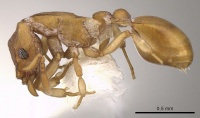Colobostruma unicorna
| Colobostruma unicorna | |
|---|---|

| |
| Scientific classification | |
| Kingdom: | Animalia |
| Phylum: | Arthropoda |
| Class: | Insecta |
| Order: | Hymenoptera |
| Family: | Formicidae |
| Subfamily: | Myrmicinae |
| Tribe: | Attini |
| Genus: | Colobostruma |
| Species: | C. unicorna |
| Binomial name | |
| Colobostruma unicorna Shattuck, 2000 | |
The only known nest was found in open sclerophyll under rocks in soil on slope of ridge, and in nests of Polyrhachis ammon and Pseudoneoponera mayri.
Identification
Shattuck (2000) - The raised frontal lobes and extreme lateral margins of the clypeus combined with a projection on the centre of the clypeus will readily separate this species from all others in the genus, including the similar Colobostruma bicorna.
Keys including this Species
Distribution
Mid to southern coastal Queensland
Latitudinal Distribution Pattern
Latitudinal Range: -21.96667° to -29.25°.
| North Temperate |
North Subtropical |
Tropical | South Subtropical |
South Temperate |
- Source: AntMaps
Distribution based on Regional Taxon Lists
Australasian Region: Australia (type locality).
Distribution based on AntMaps
Distribution based on AntWeb specimens
Check data from AntWeb
Countries Occupied
| Number of countries occupied by this species based on AntWiki Regional Taxon Lists. In general, fewer countries occupied indicates a narrower range, while more countries indicates a more widespread species. |

|
Estimated Abundance
| Relative abundance based on number of AntMaps records per species (this species within the purple bar). Fewer records (to the left) indicates a less abundant/encountered species while more records (to the right) indicates more abundant/encountered species. |

|
Biology
Castes
Nomenclature
The following information is derived from Barry Bolton's Online Catalogue of the Ants of the World.
- unicorna. Colobostruma unicorna Shattuck, in Bolton, 2000: 46, figs. 37, 48 (w.q.) AUSTRALIA (Queensland).
- Type-material: holotype worker, 16 paratype workers, 1 paratype queen.
- Type-locality: holotype Australia: Queensland, Mt Coot-tha, Brisbane, 300-800 ft, 29.xii.1964, open sclerophyll, under rocks in soil on slope of ridge, found in nests of Polyrhachis ammon and Bothroponera mayri (B.B. Lowery); paratypes with same data.
- Type-depositories: ANIC (holotype); ANIC, BMNH, MCZC (paratypes).
- Distribution: Australia.
Type Material
- Holotype, worker, Mt. Coot-tha, Brisbane, Queensland, 300-800 ft, Australia, 29 October 1964, B.B. Lowery, Australian National Insect Collection; open scerophyll, under rocks in soil on slope of ridge, found in nests of Polyrhachis ammon and Pseudoneoponera mayri.
- Paratype, 16 workers, 1 queen, Mt. Coot-tha, Brisbane, Queensland, 300-800 ft, Australia, 29 October 1964, B.B. Lowery, Australian National Insect Collection, The Natural History Museum, Museum of Comparative Zoology; open scerophyll, under rocks in soil on slope of ridge, found in nests of Polyrhachis ammon and Pseudoneoponera mayri.
Unless otherwise noted the text for the remainder of this section is reported from the publication that includes the original description.
Description
Worker
HOLOTYPE WORKER. TL 3.0, HL 0.70, HW 0.60, CI 86, ML 0.14, MI 20, SL 0.32, SI 53, PW 0.39, AL 0.80. Anterior region of head raised slightly above the posterior region and separated from it by a rounded angle, thus the head weakly but not obviously phragmotic. In full-face view ridge immediately in front of eye weakly concave. Frontal lobes immediately above the antennal insertions and the lateral margins of clypeus immediately above the mandibular insertions raised above the surrounding surface of the head; the centre of the clypeus with a distinct, raised pointed projection. Mandibles broadly triangular. Hairs absent from dorsum of head. Posterior margin of head deeply concave. Antenna with 5 or 6 segments, when 6-segmented the fourth funicular segment from the base is much shorter than the third segment. Scape weakly elbowed and without a subbasal lobe. In dorsal view the widest point of the pronotum is at the humeral angles. Propodeum high, its declivity approximately the same height as the petiolar node and with broad, thin lamellae; in profile the dorsum of the alitrunk flat with a weak convexity at the metanotal groove. Petiole with a broad, irregular ventral lamella. Lateral postpetiole drawn outwards into thin flange-like wings, the wings with translucent windows along both their anterior and posterior margins, the windows separated by a narrow band of thickened integument, the anterior windows smaller than the posterior windows. First gastral tergite with delicate reticulate sculpture which is stronger anteriorly and weaker posteriorly, the anterior one-third superimposed with low, closely spaced carinae. Body colour honey yellow, dorsum of head slightly darker.
References
- Jansen, G., Savolainen, R. 2010. Molecular phylogeny of the ant tribe Myrmicini (Hymenoptera: Formicidae). Zoological Journal of the Linnean Society 160(3), 482–495 (doi:10.1111/j.1096-3642.2009.00604.x).
- Shattuck, S. O. 2000. Genus Colobostruma. Genus Mesostruma. Genus Epopostruma. Pp. 31-67 in: Bolton, B. The ant tribe Dacetini. Mem. Am. Entomol. Inst. 65: 1-1028. (page 46, figs. 37, 48 worker, queen described)
References based on Global Ant Biodiversity Informatics
- Bolton, B. 2000. The Ant Tribe Dacetini. Memoirs of the American Entomological Institute 65


